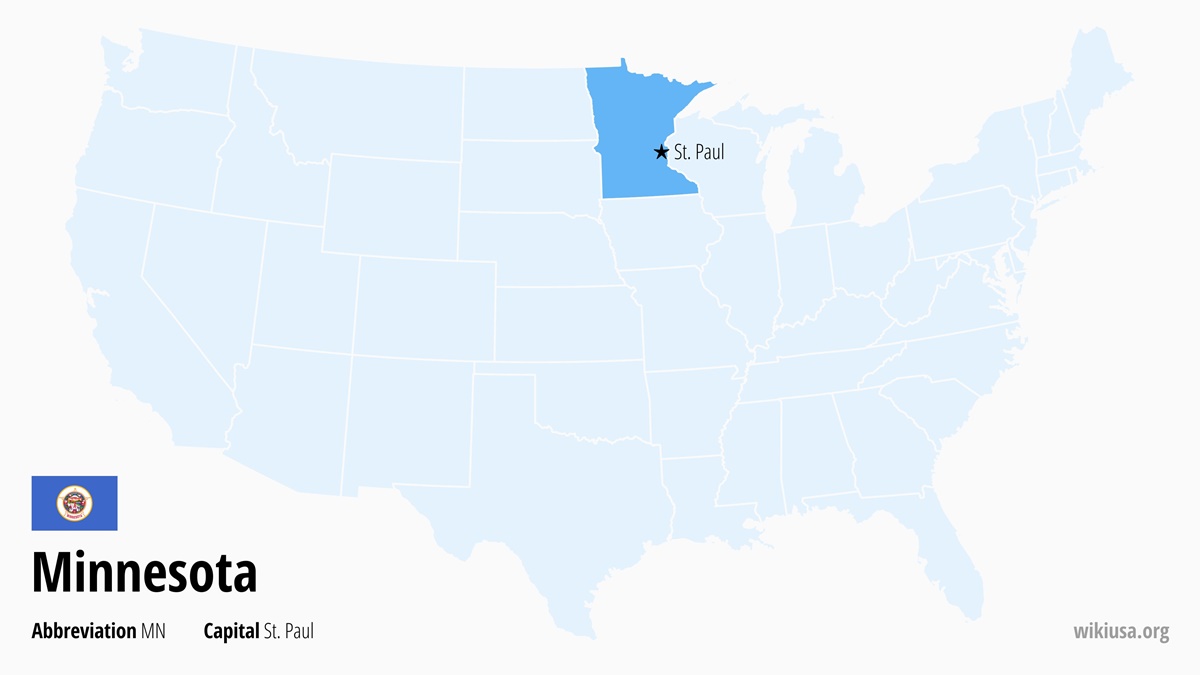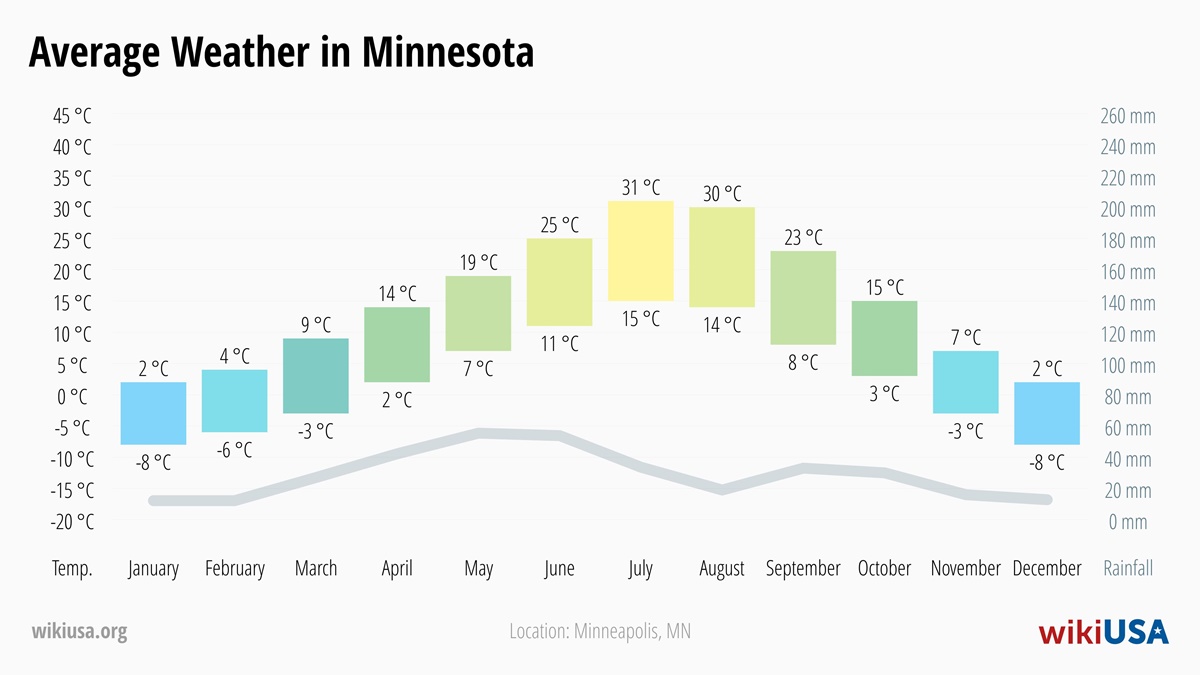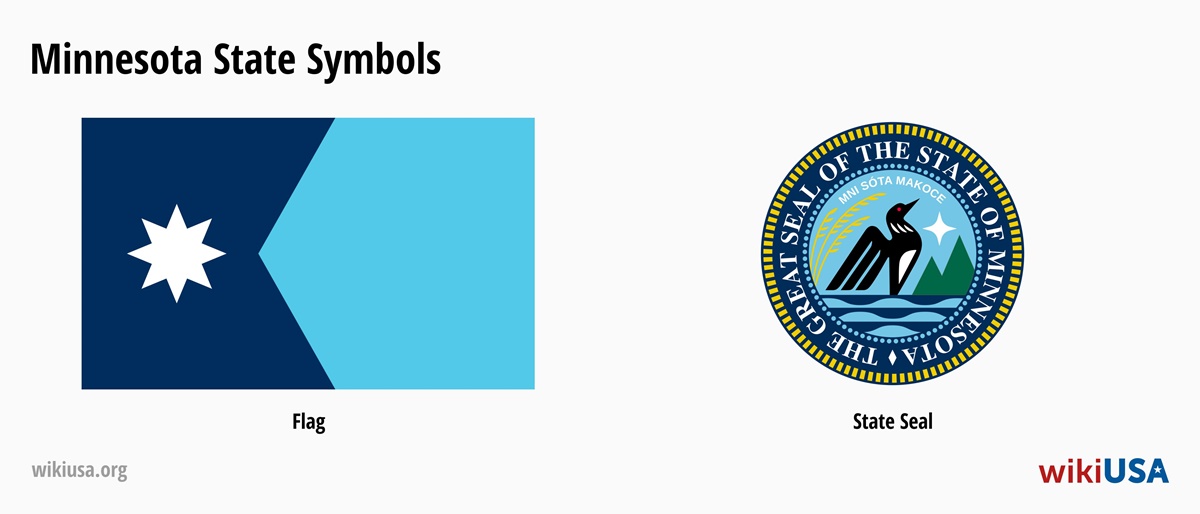Minnesota (MN) is located in the northern USA near the border with Canada and is known for its tens of thousands of lakes and excellent conditions for winter sports. Popular tourist attractions include Voyageurs National Park and the Mall of America, the largest department store in the country. Minnesota’s capital is Saint Paul, and its largest city is Minneapolis. In 1952, the world’s first successful open-heart surgery was performed at the prestigious University of Minnesota.
-
Table of Contents
Quick Facts
Name Minnesota Abbreviation MN Capital St. Paul Largest city Minneapolis (Population: 425 115) Current time 14:28 Time zone CST (UTC-6), the state observes daylight saving time CDT (UTC-5) Population 5,706,804 (#22 most populous US state) Area 86,936 sqmi (#12 largest US state) Admitted to the Union May 11, 1858 (#32 state to join) ⭐ Capital of Minnesota
The capital of Minnesota is Saint Paul, which was officially founded in November 1849 and named after the biblical figure Saint Paul of Tarsus. Saint Paul was first the capital of the Territory of Minnesota from 1849, and then the capital of the independent state after entering the Union in 1858.
🏙️ Largest City in Minnesota
The largest city in Minnesota is Minneapolis, with 425,115 people living there in 2023. The second largest city is St. Paul with a population of 303,820, and the third largest is Rochester with a population of 122,413.
🕒 Time in Minnesota
The current time in Minnesota is 14:28. Central Standard Time (CST, UTC-6) is in effect throughout the state, with Daylight Saving Time (DST) switching between March and November.
🧑🤝🧑 Population of Minnesota
In 2023, Minnesota had a population of 5,706,804, making it the 22nd most populous state in the United States.
📍 Area of Minnesota
Minnesota’s total area is 86,936 sqmi, of which 79,626 sqmi is land and 7,309 sqmi is water. Minnesota is the 12th largest US state.
-
Fun Facts About Minnesota
🧩 Minnesota Neighboring States
Minnesota is bordered by four US states. South Dakota and North Dakota to the west, Wisconsin to the east and Iowa to the south. In addition, it shares a border with the Canadian provinces of Manitoba and Ontario to the north and Lake Superior to the northeast.
📅 Date of Minnesota Statehood
Minnesota entered the Union on May 11, 1858 as the 32nd state in the order, its predecessor being the greater Minnesota Territory.
📛 Nickname of the State of Minnesota
Minnesota is nicknamed the “Land of 10,000 Lakes”, referring to the approximately 11,842 lakes of at least 10 acres in size located in the state. For historical reasons, the original designation is used, although the number of lakes is higher. The nickname is part of the license plates of all cars registered in Minnesota.
A second nickname is inscribed on the Minnesota state seal. “Mni Sóta Makoce” comes from the Dakota Indian language and translates to “the land where the sky is reflected in the waters.” The nickname thus again characterizes Minnesota as a land with a high number of bodies of water.
⛰️ Highest Mountain in Minnesota
The highest mountain in Minnesota is with 2,302 ft Eagle Mountain, which is part of the Misquah Hills. The mountain’s name comes from the language of the Ojibwe Indian tribe and translates to “red”.
🏞️ Rivers in Minnesota
The longest river in Minnesota is the Mississippi River with a total length of 2,318 mi. Next in order are the Red River of the North (553 mi), Des Moines River (525 mi), Minnesota River (373 mi), and Cedar River (338 mi).
🎓 Universities in Minnesota
The largest university in the state is the University of Minnesota, founded in 1851, today has approximately 55,000 students. The second largest university is Walden University with approximately 42 thousand students and the third largest is Capella University with approximately 40 thousand students.
✉️ Minnesota ZIP Codes
Minnesota has dedicated zip code ranges of 550xx-551xx and 553xx-567xx. For more information on how they work, see the article ZIP Codes in the USA You can look up the ZIP code for a specific address on the USPS website.
-
Weather in Minnesota
The best time to visit Minnesota is in late spring or early fall, when temperatures are pleasant and the landscape is either beginning to bloom or beautifully colored.
Spring in Minnesota is characterized by changeable weather and rapid warming. While March is still around 37 °F, by May temperatures are already around 59 °F. May is the rainiest month, which can cause flooding at lower altitudes.
Summers in Minnesota are warm and humid, with temperatures in July and August typically reaching 77 °F to 86 °F. Rain showers and thunderstorms are frequent, especially in the northern part of the state. The summer months also bring a higher risk of tornadoes.
Fall in Minnesota brings a cooling from the usual 55 °F to 64 °F in September to 39 °F in November. Rainfall totals tend to be lower, with rain gradually replacing snowfall.
Winter in Minnesota tends to be severe with temperatures below freezing, usually around 23 °F in December and January. In some areas, temperatures can drop to -22 °F. More than 150 cm of snow may fall in northern Minnesota.
🌡️ Average Temperatures and Precipitation in Minnesota
-
Things to Do in Minnesota
1️⃣ Voyageurs National Park
Voyageurs National Park is known for its pristine wilderness and vast lakes, the largest of which is Rainy Lake with depths up to 161.0 ft. During the summer months, fishing, camping, and canoeing are among the park’s popular activities. In the winter months, cross-country skiing or snowshoeing are available in Voyageurs Park. Among the animals, it is possible to spot wolves, bears or eagles.
2️⃣ Mall of America
The Mall of America is the largest mall in terms of total square footage in the USA and one of the most visited places in Minnesota. The mall is home to over 500 stores, several restaurants and entertainment attractions. One of the most interesting ones is the Sea Life Aquarium with a 300 ft long glass tunnel through which over 4,500 marine animals can be viewed, including sharks, rays and turtles.
3️⃣ Itasca State Park
Located northeast of Minneapolis, Itasca State Park is the source of the Mississippi River, one of the most important waterways in the United States. Visitors to the park can enjoy the beautiful scenery, forests, and lakes on a number of hiking trails.
An interesting experience is the opportunity to walk over the rocks where the river originates. Itasca is the oldest state park in Minnesota, having been established in 1891.
4️⃣ Split Rock Lighthouse
Split Rock Lighthouse is one of the most famous lighthouses on the northern shore of Lake Superior. It was commissioned in 1910 to help protect ships in the treacherous waters of the great lake.
The tall lighthouse served its original purpose 54.0 ft in 1969, and today, along with the adjacent museum, it documents the history of navigation on Lake Superior. Those interested can take a guided tour of the lighthouse.
5️⃣ Boundary Waters Canoe Area Nature Reserve
This nature preserve is located on the Minnesota-Canada border and consists of more than 1,000 lakes and other waterways. The area is popular with outdoor sports enthusiasts as it offers great conditions for kayaking and canoeing, fishing, camping and wildlife viewing. White-tailed deer, elk, beavers, wolves and baribal bears can be spotted. The lakes in the preserve are among the cleanest in the United States.
6️⃣ North Shore Scenic Drive
The North Shore Scenic Drive begins in Duluth and runs along Lake Superior to the Canadian border. The long 154 mi route is lined with several waterfalls, lighthouses and state parks that are worth at least a brief stop. Driving the road is an experience in any season, the most popular being autumn when the leaves on the trees turn orange and red.
7️⃣ Minnehaha Park
Minnehaha City Park is one of the largest and oldest parks in Minneapolis. Its main attraction is the 53.0 ft high Minnehaha Falls, with the most water flowing through it in the spring. The park has several hiking trails and is a good place for a picnic.
8️⃣ Minneapolis Institute of Arts
The Minneapolis Institute of Art (Mia) ranks among the most important art museums in the United States, with a collection of over 90,000 works spanning different historical periods and cultures. Founded in 1883, the museum’s most famous exhibits include paintings by Vincent van Gogh and Claude Monet. Admission to the Minneapolis Institute of Arts is free.
9️⃣ Lutsen Mountains Ski Resort
The Lutsen Mountains ski resort is located near the northern shore of Lake Superior. It offers winter sports enthusiasts nearly a hundred slopes suitable for all levels of skiers and snowboarders from beginners to the very advanced. In the summer months, the Lutsen Mountains are popular for their wide range of hiking trails, some of which offer beautiful views of Lake Superior.
🔟 Minnesota State Capitol
The Capitol Building in the state capital of Saint Paul is one of the most important buildings in Minnesota and is a fine example of late 19th century architecture. American architect Cass Gilbert designed it in the Renaissance Revival style and it was built between 1896 and 1905. The Capitol has the second largest self-supporting marble dome in the world after St. Peter’s Basilica at the Vatican.
The Capitol is open to the public on guided tours, and visitors can admire the richly decorated interiors, sculptures and historical artifacts.
-
Largest Cities in Minnesota
The table below shows the ten largest cities in the state of Minnesota in 2023, the source of the data is the United States Census Bureau, a federal agency whose main job is to count the population.
City County Population 1 Minneapolis Hennepin 425,115 Map of Minneapolis 2 St. Paul Ramsey 303,820 Map of St. Paul 3 Rochester Olmsted 122,413 Map of Rochester 4 Duluth St. Louis 87,680 Map of Duluth 5 Bloomington Hennepin 87,398 Map of Bloomington 6 Brooklyn Park Hennepin 82,017 Map of Brooklyn Park 7 Woodbury Washington 79,538 Map of Woodbury 8 Plymouth Hennepin 77,648 Map of Plymouth 9 Lakeville Dakota 76,243 Map of Lakeville 10 Blaine Anoka, Ramsey 73,774 Map of Blaine -
Sports Teams in Minnesota
🏒 Ice Hockey (NHL)
The only team in the NHL is the Minnesota Wild, which was formed in 2000 and belongs to the Central Division in the Western Conference. The team plays its home games at the Xcel Energy Center in Saint Paul, and considers forest green, red, gold, and the color of Minnesota wheat to be its symbolic colors.
🏈 American Football (NFL)
Since the 1961 season, the Minnesota Vikings have been the only team from Minnesota in the NFL, the American Football League. The club colors are purple, gold, and white, and the team is part of the North Division in the NFC Conference. The Vikings play their home games at U.S. Bank Stadium in Minneapolis.
🏀 Basketball (NBA)
The Minnesota Timberwolves, a team in the Northwest Division of the Western Conference, have played in the NBA basketball league since the 1989 season. The club colors are navy blue, blue, green, gray and white. All home games are played at the Target Center in Minneapolis.
⚾ Baseball (MLB)
The Minnesota Twins have been playing MLB since 1901; the team is ranked in the Central Division of the American League. All home games are played at Target Field in Minneapolis; the club colors are red, navy blue, and white.
⚽ Soccer (MLS)
Minnesota United FC has been part of the Western Conference of the MLS Football League since the 2017 season. The team plays its home matches at Allianz Field in Saint Paul, and has chosen gray, sky blue and black as its club colors.
-
Minnesota State Symbols
Minnesota law defines about 20 state symbols, and this article lists some of them.
State Flag of Minnesota
The flag of Minnesota is one of the youngest in the entire United States, the current design was only adopted on May 11, 2024. The left half of the flag is dark blue, with an eight-pointed white star in the upper half to symbolize Native and immigrant cultures. The right half of the flag is light blue. The transition between the colors is intended to represent the simplified shape of Minnesota.
Great Seal of Minnesota
The Great Seal of Minnesota is valid in its current form as of May 11, 2024, concealing several symbols of the state. The common loon has the most space, complemented by the lodgepole pine, wild rice, and the Polaris star as the state motto symbol.
State Bird
The official state symbol since 1961 has been the common loon (Gavia immer), with an estimated 12,000 individuals living in Minnesota.
State Fish
The walleye (Stizostedion vitreum), which is relatively common in Minnesota waters, was declared the state fish in 1965. Its preferred habitat is the cooler lakes in the north of the state.
State Flower
The Minnesota legislature declared the showy lady’s slipper (Cypripedium reginae) the state flower in 1967; the plant, 35 cm to 85 cm tall, is commonly found in swamp, marsh, or moist forest environments. It is an endangered species and its collection is prohibited.
State Fruit
The symbol is the Honeycrisp apple tree, which was specially bred at the University of Minnesota to survive the state’s harsh climate. It became the official fruit of Minnesota in 2006.
State Gem
Since 1969, the official gemstone has been agate from the area around Lake Superior, which is characterized by its bright orange to red coloration due to the high proportion of iron ore in the soil.
State Tree
Since 1953, the state symbol of Minnesota has been the red pine (Pinus resinosa), which grows to a height of 59 ft to 98 ft. Rich stands of pine trees can be found, for example, in Itasca State Park.
State Muffin
In 1988, the blueberry muffin became one of the state symbols at the suggestion of Carlton Elementary School students. Wild blueberry trees are typical of the forests of northeastern Minnesota.
State Drink
Minnesota is a major milk producer among US states. In 1984, milk became the state’s official beverage in an effort to support the local dairy industry.

 10 Best Photo Places in the USA
10 Best Photo Places in the USA







Contribute with Your Question or Personal Experience